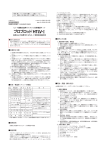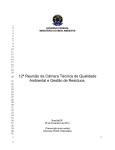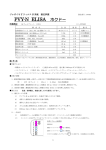Download HIV-1 p24 ELISA Kit: Overview
Transcript
General precautions 1. This product is a reagent for use in research, and should not be used for other purposes. 2. This product should be used in accordance with the methods stipulated in the Package Insert. 3. This product should be used after carefully reading the leaflets, and the explanatory documents about handling, relating to the equipment used. HIV-1 p24 ELISA Kit: Overview The HIV-1 p24 ELISA Kit is used to measure the amount of HIV-1 p24 antigen in samples, by means of the enzyme-linked immunosorbant assay (ELISA). HIV-1 p24 antigen measurement is included in the fourth-generation ELISA, in the human immunodeficiency virus (HIV) tests. This Kit is used in research, for quantification of the HIV-1 p24 antigen. Because a detection antibody conjugated with horseradish peroxidase (HRP) is used, the process can be completed by carrying the reaction out once, in contrast with other ELISA kits, in which biotin-conjugated antibodies are used, although this depends upon the antibody type. With this Kit, there is cross-reactivity with HIV-2 p26, which corresponds to HIV-1 p24, reducing the sensitivity, yet quantification is still sometimes possible. Details of Kit composition No. Reagent Properties 1 Solid-phase Plate Specifica- Principal tions components 96 wells Anti-HIV-1 microplate p24 murine mono-clonal The HIV-1 p24 ELISA Kit is a sandwich, enzyme-linked, immunological detection kit involving the use of polystyrene micro-wells coated with anti-HIV-1 p24 antibody. In the first step, the p24 antigen standard and antibody treated with a surface-active agent are introduced to the wells. For measurement of samples not containing sodium nitride and EDTA, or citric acid, HRP-conjugated anti-HIV-1 p24 antibody is added as the capture antibody, followed by incubation for 1 hour. On the other hand, for measurement of antibodies containing sodium nitride and EDTA, or citric acid, just the antigen and antibody are added beforehand, followed by incubation for 1 hour, washing, and then addition of HRP-conjugated anti-HIV-1 p24 capture antibody, and incubation for another hour. If the sample contains p24 antigen, it is captured in the wells, and at the same time a sandwich is formed with HRP-conjugated p24 antibody. In order to exclude unbound HRP-conjugated antibody, the micro-wells are washed, and an enzyme-substrate chromogen solution is added. In the case of wells containing the antibody-p24-antibody HRP sandwich immunocomplex, the solution undergoes blue coloration, but if the reaction is stopped by addition of sulfuric acid the color of the solution changes from blue to yellow. The coloration intensity is correlated to the antigen content of the sample, and wells containing samples without HIV-1 p24 remain colorless. antibody 2 HIV-1 p24 Liquid 1 mL × 1 Recombinant standard bulk HIV-1 p24 solution Antigen (2000pg/mL) 3 HRP-conjugated Liquid 0.1 mL × 1 antibody (×100) HRPconjugated HIV-1 p24 antibody 4 Antigen/antibody Liquid 100 mL × 1 (Ag/Ab) dilution Phosphate buffer buffer 5 Concentrated Liquid 50 mL × 1 wash buffer Phosphate buffer (×20) 6 Chromogen Liquid 8 mL × 1 Citrate buffer Liquid 8 mL × 1 Citrate buffer Liquid 8 mL × 1 2 N sulfuric solution A 7 Chromogen solution B 8 Stop solution acid Additional item included: Three sheets of adhesive film. 1 for example, either the number of washing cycles or the time for which the wash buffer is left in the well in each cycle should be increased. Materials and equipment required other than included in Kit 1. Purified water 2. Micro-pipette (25 to 1000 µL) 3. Measuring cylinder (25 to 1000 mL) 4. Microplate-washer 5. Microplate-reader (single wavelength of 450 nm; or two wavelengths, with main wavelength of 450 nm, and reference wavelength of 650 nm). 6. Paper towels 7. Disposable gloves 8. Agents and/or devices for treatment of liquid waste Safety and precautions 1. The reagents should not be mixed between kits of different manufacturer’s lots. At the time of the test, the reagents in this Kit should be prepared carefully, so that the optimal test results can be obtained. 2. Reagents should not be used when the use expiry date has passed. 3. Reagents and samples should be returned to room temperature (18 to 30ºC) before use. 4. After washing, care should be taken to not allow the microplates to dry. 5. Any samples collected from humans have the potential to be infective, and the appropriate precautions should therefore be taken. 6. Pipette tips, and tubes that have been used for measurement should be treated appropriately, with respect to wastewater, etc., and should then be disposed of. 7. If any of the stop solution is spilt, it should be wiped up immediately. If it comes into contact with the skin or eyes, these should be washed with water. 8. The enzymatic activities of HRP-conjugated compounds can be affected by materials such as dust, reactive drugs, sodium hypochlorite, acids, and alkalis, and measurements should therefore be carried out in places where these are not present. 9. The relevant Material Safety Data Sheets will be provided as requested. Precautions relating to operations Samples for measurement include cell culture supernatants, cell lysates, serum, and plasma. 1. When measurements are carried out with samples containing sodium nitride and EDTA, or citric acid, the reactions should be carried out by the two-step method (Measurement Method 2). 2. Care should be taken to not allow microbial contamination of serum and plasma samples. 3. There is the potential for incorrect results with chyle-containing plasma samples, samples from jaundice patients, and hemolytic samples, so the Kit should not be used with these. 4. Measurements can be carried out even if samples have been inactivated. 5. Samples should be stored at 2 to 8ºC. Samples with which tests are not needed within 3 days should be stored frozen at −20ºC or lower. 6. Reagents and samples should not be repeatedly frozen and thawed. Preparation Preparation stage 1: Wash buffer is prepared by mixing the concentrate with distilled or de-ionized water in a 1:20 ratio. Preparation stage 2: The required number of strips is placed in the strip-holder. Unused strips are returned to the pack. Preparation stage 3: HRP-conjugated anti-HIV-1 p24 antibody is prepared. The amounts of HRP-conjugated antibody to be used are measured as portions into tubes, and then diluted to the dilution concentrations required by Measurement Method 1 or 2, using the Ag/Ab dilution buffer. Precautions relating to washing 1. A high-quality ELISA microplate-washing device is recommended, so that a high level of washing performance can be maintained. In general, in order to avoid false-positive reactions and high background levels, automated washing is recommended, with at least five cycles, each at 350 to 400 µL/well. 2. If washing is carried out manually, it should involve five cycles, with 350 to 400 µL/well of wash buffer being added in each cycle, following by removal by aspiration. If the results are poor, with high background levels, 2 Measurement Method 1 This is used when samples not containing sodium azide and EDTA, or citric acid are measured. 1. Standard HIV-1 p24 solution is diluted stepwise with Ag/Ab dilution buffer, and 50 µL is added to each well. The measurement sample is also added to each well, in 50-µL aliquots. For the blank, 50 µL of the Ag/Ab dilution buffer is added to a well. 2. HRP-conjugated antibody prepared by 100-fold dilution with Ag/Ab dilution buffer is added to each well in 50-µL aliquots. 3. The wells are covered with a plate-sealer, and allowed to react at room temperature for 60 minutes. 4. Each well is washed five times with diluted wash buffer. If the washing is manual, the micro-wells are filled for 30 to 60 s in each cycle, and after the final washing cycle the plate is inverted over highly absorbent tissue paper, and tapped lightly to remove remaining liquid. 5. To each well, including the blanks, 50 µL each of chromogen solutions A and B are added, and the plate is covered with a plate-sealer, and gently agitated, followed by incubation for 15 minutes at room temperature with protection from light. 6. To each well, 50 µL of stop solution is added, following by gentle agitation. 7. Optical absorbance is measured using a plate-reader, with the measurement wavelength being 450 nm, and the reference wavelength being 650 nm. The absorbance should be measured within 15 minutes after stopping the reaction. 3. 4. 5. 6. 7. 8. 9. Measurement Method 2 This is used when samples containing sodium azide and EDTA, or citric acid are measured. 1. Standard HIV-1 p24 solution is diluted stepwise with Ag/Ab dilution buffer, and 100 µL is added to each well. The measurement sample is also added to each well, in 100-µL aliquots. For the blank, 100 µL of the Ag/Ab dilution buffer is used. 2. The wells are covered with a plate-sealer, and 3 allowed to react at room temperature for 60 minutes. Each well is washed five times with diluted wash buffer. If the washing is manual, the micro-wells are filled for 30 to 60 s in each cycle, and after the final washing cycle the plate is inverted over highly absorbent tissue paper, and tapped lightly to remove remaining liquid. HRP-conjugated antibody prepared by 200-fold dilution with Ag/Ab dilution buffer is added to each well in 100-µL aliquots. The wells are covered with a plate-sealer, and allowed to react at room temperature for 60 minutes. Each well is washed five times with diluted wash buffer. If the washing is manual, the micro-wells are filled for 30 to 60 s in each cycle, and after the final washing cycle the plate is inverted over highly absorbent tissue paper, and tapped lightly to remove remaining liquid. To each well, including the blanks, 50 µL each of chromogen solutions A and B are added, and the plate is covered with a plate-sealer, and gently agitated, followed by incubation for 15 minutes at room temperature with protection from light. To each well, 50 µL of stop solution is added, following by gentle agitation. Optical absorbance is measured using a plate-reader, with the measurement wavelength being 450 nm, and the reference wavelength being 650 nm. The absorbance should be measured within 15 minutes after stopping the reaction. Calibration curve Storage and stability The kit is stored at 2 to 8ºC, without freezing. Precautions relating to use This kit is for research use, and should not be used for diagnoses, etc. Manufacturing & Technical Support RYUKYU IMMUNOLOGY CORPORATION Tel.: 098-943-3740; fax: 098-943-3740 E-mail: [email protected] 4 HIV-1 p24 ELISA キットの概要 HIV-1 p24 ELISA キット は、酵素結合免疫測 ▶ キット構成内容 No. 定法(ELISA)を用いて、検体中の HIV-1p24 抗原を定量す 1 るものです。この方法は HIV 検査の第 4 世代 ELISA にも組 試 薬 固相マイクロプレート 性 状 規 格 主 要 成 分 プレート 96 ウェル 抗 HIV-1 p24 マウスモノクロー ナル抗体 み込まれています。このキットは、HIV-1 p24 抗原を定量 するための研究用キットとして使用します。HRP を標識し 2 た検出抗体を使うため、検体の種類によりますが、ビオチ HIV-1 p24 標準原 液 状 1mlx1 リコンビナント HIV-1 p24 抗 液(2000pg/ml) 原 ン標識抗体を用いる他社の ELISA キットと比べ、反応は1 3 回で済みます。また、このキットは、HIV-1 p24 に相当す HRP 標識抗体 ( る HIV-2 の p26 にも交差反応することから、感度は低い 液 状 0.1mlx1 HRP 標識抗 HIV-1 p24 100) 抗体 ながらその定量ができる場合があります。 4 抗原抗体希釈液 液 状 100mlx1 リン酸緩衝液 5 洗浄液( 液 状 50mlx1 リン酸緩衝液 6 発色液 A 液 状 8mlx1 クエン酸緩衝液 7 発色液 B 液 状 8mlx1 クエン酸緩衝液 8 反応停止液 液 状 8mlx1 2N 硫酸 HIV-1 p24 ELISA キット は「サンドイッチ」 酵素免疫測定キットであり、抗 HIV-1 (p24)抗体でコート されたポリスチレン・マイクロウェルを使用しています。 最初のステップとして、p24 抗原スタンダードと界面活性 剤処理した検体をウェルに注入します。チッ化ソーダや 20) 付属品:粘着フィルム 3 枚 EDTA またはクエン酸を含まない検体の測定では、ペルオ キジダーゼ(HRP)標識された捕獲用の抗 HIV-1p24 抗体を ▶ キット構成品以外に必要な材料・器具 加え1時間インキュベーションします。一方、チッ化ソー ダや EDTA またはクエン酸を含む検体の測定では、予め抗 原や検体のみを加えて1時間インキュベーションし、洗浄 後 に 、 ペ ル オ キ ジ ダ ー ゼ (HRP) 標 識 さ れ た 捕 獲 用 の 抗 HIV-1p24 抗体を加え1時間インキュベーションします。 検体に p24 抗原が存在する場合、ウェルの中に捕獲され、 1. 精製水 2. マイクロピペット(25∼1000µl) 3. メスシリンダー(25∼1000ml) 4. マイクロプレートウォッシャー 5. マイクロプレートリーダー(単 1 波長:450nm または 2 波長:主波長 450nm、参照波長 650nm) 同時に HRP 標識 p24 抗体でサンドイッチされます。未結合 の HRP 標識抗体を除去するためマイクロウェルを洗浄し、 その後、酵素基質発色液をウェルに加えます。 Ab-p24-Ab(HRP)のサンドイッチ免疫複合体を含むウェル 6. ペーパータオル 7. 使い捨て手袋 8. 廃液処理液/廃液処理容器 では、無色から青色の溶液に変化します。硫酸を加えて反 ▶ 操作上の注意 応を停止すると、溶液の色が青色から黄色になります。色 の濃さは検体中の抗原の量と相関します。HIV-1 p24 が陰 測定検体について 性の検体を入れたウェルは無色のままです。 検体は、細胞培養上清、細胞可溶化物、血清や血漿で す。 ▶ 全般的な注意 1)チッ化ソーダや EDTA またはクエン酸を含む検体を 1. 本品は研究用試薬ですので、それ以外の目的には使用 測定する場合は、2ステップ方法で反応を行ってくだ しないでください。 さい。 2. 添付文書に記載の使用方法に従ってください。 (測定方法2参照) 3. 使用する機器の添付文書および取扱説明書をよく読ん 2)血清や血漿検体は微生物に汚染されないように注意 してください。 でから使用してください。 3)乳糜血漿や、黄疸、溶血したサンプルなどは誤った 検査結果が出る可能性がありますので、使用しないで ください。 4)検体は非働化しても測定できます。 5)検体は 2‐8℃で保管してください。3 日以上検査す る必要がない検体は凍結保存(‐20℃以下)してくだ さい。 1 ▶ 測定方法1:チッ化ソーダや EDTA またはクエン酸を 6)試薬やサンプルを繰り返し凍結・解凍をする事はさ けてください。 含まない検体を測定するとき (1) HIV-1 p24 標準溶液を抗原抗体希釈溶液で段階希釈し、 ▶ 洗浄の注意 各ウェルに 50µl ずつ加えます。測定サンプルも 50µl ずつ 1. 高いレベルの洗浄能力を保った高品質な ELISA 用マ 各ウェルに加えます。ブランクには抗原抗体希釈溶液を イクロプレート洗浄機を推奨します。一般的に偽陽 50µl 加えます。 性反応と高いバックグラウンドを防ぐため、350‐ (2) 抗原抗体希釈液で 100 倍希釈に調製した HRP 標識抗体 400μl/ウェルの 5 回以上の自動洗浄サイクルを推奨 を 50µl ずつ各ウェルに添加します。 します。 (3) プレートシールで覆い、室温で 60 分間、反応させま 手動洗浄する場合 5 サイクル、350‐400μl/ウェル す。 を注入し溶液の吸引という操作を 5 回繰り返す事を (4) 各ウェルを 5 回、希釈洗浄バッファーで洗浄します。 薦めます。結果が思わしくない場合(高いバックグ (手動洗浄する場合、毎回 30‐60 秒程マイクロウエルを浸 ラウンド)には、各ウェルの洗浄サイクルか漬込み しておきます。最終洗浄サイクルの後、吸収性の高いティ 時間を増やしてください。 ッシュの上にプレートを逆さにし、軽くたたいて残りの液 2. 体を取り除きます。) ▶ 安全性と注意事項 (5) ブランクを含めた各ウェルに 50µl の発色液 A と 50µl 1. 試薬は別ロットのキットと混ぜないでください。本 の発色液 B を添加し、プレートシールでプレートを覆い、 キットの試薬は検査時、最適な検査結果がでるよう 軽くプレートをたたき攪拌させてください。遮 光 し 、 室 に厳密に調整されています。 温で 15 分間インキュベートします。 2. 使用期限を過ぎた試薬は使用しないでください。 (6)各ウェルに反応停止液を 50μl ずつ加え、軽く攪拌さ 3. 使用前、試薬とサンプルは室温(18‐30℃)に戻し せてください。 てください。 (7) プレートリーダーで吸収度を測定します。 4. ・測定波長 450nm 洗浄後、マイクロプレートを乾燥させないよう注意 ・参照波長 650nm してください. 5. 6. 7. 8. 9. 人から採取した検体は全てに感染性のある可能性が (注:反応停止後は、15 分以内に吸光度を測定してくだ ありますので注意してください。 さい。) 測定に使用したチップやチューブ、廃液などは適切 な処理をしてから廃棄してください。 ▶ 測定方法2:チッ化ソーダや EDTA またはクエン酸を 反応停止液をこぼした場合はただちに拭き、肌や目 含む検体を測定するとき に触れた場合は水で洗浄してください。 (1) HIV-1 p24 標準溶液を抗原抗体希釈溶液で段階希釈し、 HRP 標識化合物の酵素活性は、塵、反応薬剤や次亜塩 各ウェルに 100µl ずつ加えます。測定サンプルも 100µl 素酸ナトリウム、酸、アルカリ等の影響を受ける可 ずつ各ウェルに加えます。ブランクには抗原抗体希釈溶液 能性がありますので、これらの影響が無い場所で測 を 100µl 加えます。 定を行ってください。 (2) プレートシールで覆い、室温で 60 分間、反応させま 成分安全データ資料は問い合わせにより提供します。 す。 (3) 各ウェルを 5 回、希釈洗浄バッファーで洗浄します。 ▶準備 (手動洗浄する場合、毎回 30‐60 秒程マイクロウエルを浸 準備その1:洗浄バッファーを 1:20 の割合で蒸留水又 しておきます。最終洗浄サイクルの後、吸収性の高いティ は脱イオン水で調製します。 ッシュの上にプレートを逆さにし、軽くたたいて残りの液 準備その2:必要な数のストリップをストリップ・ホル ダーにセットしてください。使わないスト 体を取り除きます。) リップは、元のバックに返して下さい。 (4) 抗原抗体希釈液で 200 倍希釈に調製した HRP 標識抗体 準備その3:HRP 標識抗 HIV-1 p24 抗体の調製 を 100µl ずつ各ウェルに添加します。 HRP 標識抗体は使用する分量を別のチュ (5) プレートシールで覆い、室温で 60 分間、反応させま ーブに測り、測定方法 1 または 2 に従った す。 希釈濃度に抗原抗体希釈液で希釈してく (6) 各ウェルを 5 回、希釈洗浄バッファーで洗浄します。 ださい。 (手動洗浄する場合、毎回 30‐60 秒程マイクロウェルを 2 浸しておきます。最終洗浄サイクルの後、吸収性の高い ティッシュの上にプレートを逆さにし、軽くたたいて残 りの液体を取り除きます。) (7) ブランクを含めた各ウェルに 50µl の発色液 A と 50µl の発色液 B を添加し、プレートシールでプレートを覆い、 軽くプレートをたたき攪拌させてください。遮 光 し 、 室 温で 15 分間インキュベートします。 (8)各ウェルに反応停止液を 50μl ずつ加え、軽く攪拌さ せてください。 (9) プレートリーダーで吸収度を測定します。 ・測定波長 450nm ・参照波長 650nm (注:反応停止後は、15 分以内に吸光度を測定してくだ さい。) ▶ 検量線 ▶ 保存と安定性 キットは凍結せずに 2‐8℃で保管してください。 ▶ 使用上の注意 本キットは研究用です。診断等には使用できません。 ▶ 技術サポート 株式会社琉球免疫研究所 TEL: 098-943-3740, FAX: 098-943-3740 E-mail: [email protected] 3










